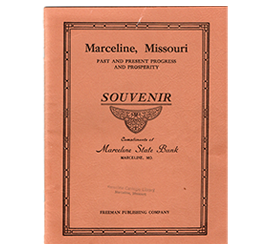As drill testing for coal was their livelihood, two brothers, Stephen Albert and Enoch Landreth invested in a small hollow rod turn drill which they purchased from Peter Carmichael for $500.
This was in 1905 and shortly after, they were joined in this enterprise by their brother, Joseph.
Their first drilling was done on the Landreth farm. At 40 feet they found a 36 inch vein of coal. Enoch had been turning the power driven drill by hand which was often necessary, in order to assist in difficult cutting. This was strenuous work. Suddenly, he became ill and called to his brother, Joseph who told him to stand back, as he lighted a match.
Imagine their surprise when ignited gas sent up and eight foot flame. Later Enoch attached thirty feet of pipe to the casing. The bright and continuous flame at this height was visible for quite a distance. It was estimated that there was sufficient gas to heat two dwellings.
Naturally, the citizens of the Marceline vicinity were very excited about the discovery of gas and what its possible development could mean to the community.
George Early, cashier of the First National Bank of Marceline, formed a company for the purpose of developing the gas well. Stock in the company was sold to citizens of the community at ten dollars per share. Although this project was discouraged by the Landreth family, 500 shares of stock were sold.
The company employed Harve Stewart of Mendon and his helper, William Graves. Stewart owned a large drill and had just finished drilling an artesian well at Triplett. It required 23 wagons to move the derrick to the Landreth farm. When erected it stood at a height of 75 feet.
At quite a depth, they encountered a large vein of fresh water; at 500 feet, a larger vein of salt water and at 800 feet, another vein of fresh water. Other veins of coal, also, were found but the water veins and the depth would have made it both difficult and unprofitable to mine the coal.
For the first 40 of drilling, 12 inch pipe was used, then 10 inch pipe inside the 12 inch pipe to a depth of 940 feet and then six inch pipe inside the 10 inch pipe to a depth of 2,004 feet. This drilling was made through layers of ordinary soil slate, coal, fire clay, salt water, fresh water and solid rock.
With no visible sign of ultimate success and company funds exhausted, the drilling finally stopped. In 1908, the derrick was dismantled and moved away. Still standing above ground today, is some of the pipe – the only tangible evidence of Marceline’s dream of a gas well.
